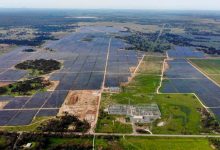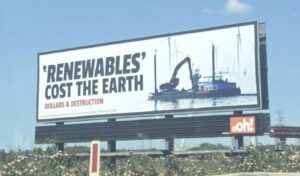This article is the second of a pair that examines the value of citing diversity of renewable electricity generation in justifying interconnection between NEM regions.
The Australian Energy Market Operato says the massive VNI-West interconnector is justified by the trade of renewables between Victoria and NSW. On ABC’s Radio National, AEMO has said that the export of rooftop solar electricity from Victoria to NSW justifies VNI-West. And at the recent AFR energy summit, AEMO’s CEO pointed to sunny and warm Sydney versus cold and windy Melbourne by way of justifying VNI-West.
Do these weather differences deliver diversity in renewable electricity production that is sufficiently valuable as to justify the cost of VNI-West, as AEMO says is the case?
To recap, since variable renewable production costs do not differ greatly amongst the NEM regions, the claim of the benefits of interconnection relies critically on the claim of their ability to diversify supply risk.
The first article focused on the hourly average of the five minute production of variable renewables in NSW, SA and VIC, and on the correlation of their production.
It found high correlation formally measured through the conventional measure of correlation – Pearson Product Moment, and it was also visually evident in the pattern of hourly average production.
From this is I concluded that diversification of rooftop solar supply between NSW and VIC was unlikely to create anywhere near enough value to needed to justify VNI-West.
Here, I extend this analysis by asking the question: If I assumed 1kW of rooftop solar / farmed solar / farmed wind in NSW and the same in Victoria, how much more electricity could I get in Victoria over a year if I counted all the electricity produced by rooftop solar / farmed solar / farmed wind produced in NSW when it exceeds the electricity produced by those sources in Victoria? And vice versa.
Answering this question provides an explicit calculation of diversity.
And then I ask, what is the breakeven price that is needed for such inter-regional trade in order to generate enough trade income to cover the cost of VNI-West? This second question is the traditional infrastructure/trade economics question: does the benefit of trade justify the creation of infrastructure to facilitate such trade?
The data I used to answer these questions is the five-minute regional aggregates for NSW and Victoria based on the farm-specific DUID Scada data (for farmed solar and wind) and AEMO’s estimate of rooftop solar generation published by AEMO on NEMWeb.
I have taken these data for the year to 7 October, 2023. As before I have normalised (expressed production in five minutes as a percentage of annual peak production) so as to get the temporal variation in the pattern of supply, undistorted by the quantity of supply.
Let me start with rooftop solar (RTS). The answer to my question is 368 kWh per kW of NSW RTS. In other words, if I added up the difference between the RTS in NSW and Victoria for all five minutes measurements over the year in which the RTS in NSW was more than RTS in Victoria, I get 368 kWh per kW of RTS in NSW.
And in reverse (when RTS in Victoria exceeds RTS in NSW) I get 179kWh. Adding these two numbers up I get 547kWh of diversification trade from the 2kWs of RTS, one each in NSW and Victoria.
Turning to VNI-West, the incremental NSW-VIC transfer capacity that it offers above the existing VNI, is 950 MW and it will cost at least $487m per year for 50 years.
Now we can put together the information on the volume of diversified RTS with the cost of VNI West, to answer the question: what must be the break-even price of the inter-regionally traded RTS that will justify VNI-West allowing for enough RTS to be able to fill (at peak) the capacity of the interconnector (950 MW) ?
Let’s work up the calculation: if 1 kW RTS in NSW and 1 kW in VIC gives a “diversity trade” of 547 kWh per year, then 950 MW of RTS in VIC and 950 MW of RTS in NSW (950 MW is the transfer capacity of VNI-West) gives 525 000 MWh per year.
So, if we are to cover the cost of VNI-West on the basis of the RTS diversity trade, then we need a break-even price on that diversity trade of $487m/525 000 MWh = $928 per MWh. Just be clear, this price is in addition to the price that that PV electricity would have got in its home market (if it was not sent down the interconnector it would be consumed in its home market)
Now, the volume-weighted average price of rooftop solar sold in Vic over my study period was $12/MWh and in NSW it was $59/MWh. There is a snow ball’s hope in hell of the inter-regional trade of rooftop solar between NSW and VIC ever getting a price of $928/MWh. The conclusion therefore is that it makes no sense to build VNI-West to facilitate a trade in surplus RTS between NSW and VIC.
Of course such a result is intuitively consistent with the observation in the first article of such strong correlation between RTS in VIC and NSW. Consequently with such small volumes, the prices for the trade of tiny surpluses must be extremely high to justify interconnection.
What about farmed solar? The data reveals that over my study period there was 507 kWh per year per kW of farmed solar diversification when NSW exceeds VIC. And when VIC exceeds NSW, the number is 211 kWh. So added together that is 718 kWh of inter-regional diversification from 2 kW of farmed solar, one each in NSW and VIC.
Since this is a bit bigger than RTS (as we expect) we must expect the break-even price needed to justify VNI-West on the basis of such trade to be a bit lower. And so it is. Proceeding as before, the calculation is $487m divided by 682 000 MWh = $714/MWh.
Again there is a snow ball’s hope in hell of the inter-regional trade of farmed solar ever getting a price of $714/MWh. And again the conclusion therefore is that it makes no sense to build VNI-West to facilitate a trade in farmed solar between NSW and VIC. And again such a result is intuitively consistent with the observation in the first article of such strong correlation of farmed solar production.
What about wind generation? The data reveals that there was 824 kWh per kW per year of wind generation diversification. i.e. the amount added up over a year by which wind generation in NSW exceeds wind generation in VIC in any five-minute trading period. And when VIC exceeds NSW, the number is 803 kWh. So added together that is 1 627 kWh per year of inter-regional diversification from 2 kW of wind generation, one each in NSW and VIC.
Proceeding as before gives a break-even price for the inter-regional trade of wind needed to justify VNI-West, of $299/MWh. To put this into context, the volume-weighted average spot price of wind in VIC in the study period was $40/MWh and in NSW it was $97/MWh.
Here we can channel Sheehan & Tennant’s “Staged”: “Is there a world in which the average inter-regionally traded value of wind generation between NSW and VIC is $299/MWh, on top of the home market price, for the next 50 years?” Perhaps for a few 5-minute trading intervals in those 50 years, but on average over 50 years, or for any single year in those 50 years? Snow-ball’s hope in hell.
So, why does AEMO keep claiming that VNI-West is justified on the basis of the diversity of wind and solar production between NSW and VIC, when the data shows so clearly that this is not the case? Can you explain it?
Professor Bruce Mountain is the director of the Victoria Energy Policy Centre







